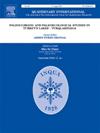Diachronic reconstruction of palaeoclimates and diet through stable isotopes (δ13C and δ18O) and 2D geometric morphometrics from cave bear (Ursus spelaeus) dentition
IF 1.8
3区 地球科学
Q3 GEOGRAPHY, PHYSICAL
引用次数: 0
Abstract
Europe experienced periods of significant climatic fluctuation during the late Pleistocene, which is likely to have led to environmental stress on many species, including the extinct cave bear Ursus spelaeus. We investigated temporal variation in carbon and oxygen isotopic values extracted from dental enamel of U. spelaeus specimens from multiple stratigraphic units within Scladina Cave, Belgium, in conjunction with dental morphology, which we quantified using 2D geometric morphometrics to test the hypothesis that Pleistocene climatic changes impact phenotypic variation and feeding ecology of extinct megafauna. Size and shape of the second lower molar differ in cave bears across several stratigraphic units, even for short temporal gaps between sediment depositions (∼3ky). Ursus spelaeus from Scladina exhibited low δ13C values comparable to that of contemporary herbivores from the same sequence, suggesting an herbivorous diet for the species throughout the temporal sequence. Climatic change had an impact on size and diet, with larger dentition relating to previously suggested colder environmental periods. The existence of these periods was further supported by our δ13C and δ18O measurements. Warmer periods were indicated by higher δ18O values and correlated with lower δ13C values indicative of a diet enriched in plant sources from more forested environments. The environmental variation through the studied sedimentary units of Scladina Cave is discussed and interpreted alongside previously produced palynological results for units herein. Our results support previous suggestions that cave bears from Scladina Cave had a herbivorous diet, while further strengthening the current stratigraphic interpretation of the cave.
通过稳定同位素(δ13C和δ18O)和二维几何形态重建洞熊(Ursus spelaeus)牙列的古气候和饮食
欧洲在更新世晚期经历了显著的气候波动时期,这很可能导致许多物种面临环境压力,包括灭绝的洞熊熊。利用二维几何形态计量学对比利时斯卡拉迪纳洞穴内多个地层单元的U. spelaeus标本牙釉质中碳、氧同位素值的时间变化进行了研究,并结合牙形态进行了量化,以验证更新世气候变化影响已灭绝巨型动物表型变化和食性生态的假设。在不同地层单元的洞熊中,第二个下臼齿的大小和形状不同,即使沉积物沉积之间的时间间隔很短(~ 3ky)。来自斯卡拉迪纳(Scladina)的熊齿兽(Ursus spelaeus)的δ13C值与来自同一序列的当代食草动物相当,表明该物种在整个时间序列中都是食草动物。气候变化对体型和饮食产生了影响,更大的牙列与之前提出的更冷的环境时期有关。δ13C和δ18O的测量结果进一步证实了这些周期的存在。较高的δ18O值与较低的δ13C值相关,表明它们的饮食中富含来自更多森林环境的植物来源。本文结合前人的孢粉学研究结果,讨论并解释了斯卡拉迪纳洞穴沉积单元的环境变化。本研究结果支持了前人关于斯卡拉迪纳洞熊为食草动物的观点,同时进一步加强了目前对洞穴的地层解释。
本文章由计算机程序翻译,如有差异,请以英文原文为准。
求助全文
约1分钟内获得全文
求助全文
来源期刊

Quaternary International
地学-地球科学综合
CiteScore
5.60
自引率
4.50%
发文量
336
审稿时长
3 months
期刊介绍:
Quaternary International is the official journal of the International Union for Quaternary Research. The objectives are to publish a high quality scientific journal under the auspices of the premier Quaternary association that reflects the interdisciplinary nature of INQUA and records recent advances in Quaternary science that appeal to a wide audience.
This series will encompass all the full spectrum of the physical and natural sciences that are commonly employed in solving Quaternary problems. The policy is to publish peer refereed collected research papers from symposia, workshops and meetings sponsored by INQUA. In addition, other organizations may request publication of their collected works pertaining to the Quaternary.
 求助内容:
求助内容: 应助结果提醒方式:
应助结果提醒方式:


